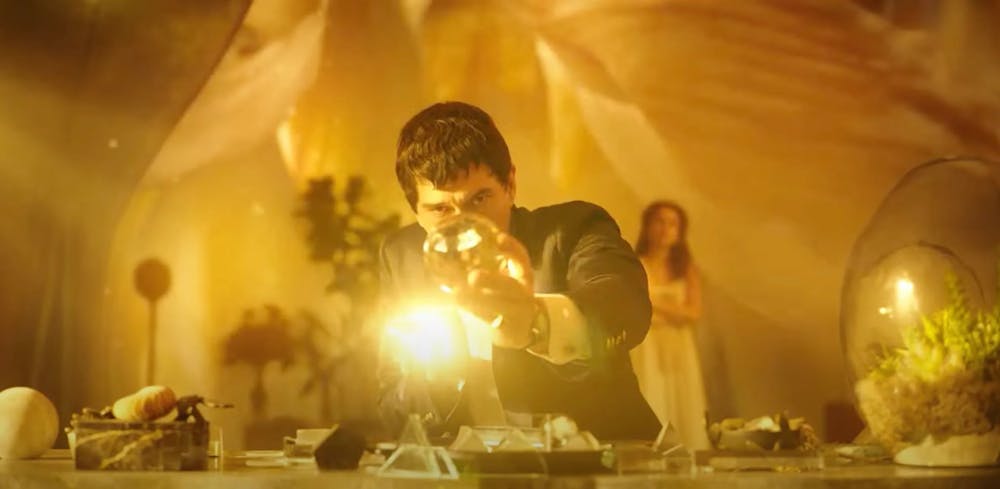Brain scrambled, eyes wide, jaw on the floor, practically stumbling out of the Georgetown AMC; “he completely wasted his money,” were the words I heard behind me. “He:” Francis Ford Coppola. “The money:” the $120 million he poured into “Megalopolis” and will never see back.
Coppola has been self-financing his films since the turn of the century. Wanting to learn more about the medium by directing smaller, self-funded, more personal films, Coppola played around with digital filmmaking while releasing “director’s cuts” of some of his earlier movies — all motivated by his disdain for the state of the industry.
“Everything was on such a scale, the budgets were so big,” Coppola said in an interview with Yahoo News. “I decided I didn’t want to make what you could call ‘factory movies’ anymore, I would rather just experiment with the form and see what I could do.”
Through his own volition, “Megalopolis” has Coppola functioning on this large scale of moviemaking. He previously spent less than $20 million combined on his other independent 21st-century films – “Youth Without Youth,” “Tetro” and “Twixt” — while “Megalopolis” had that amount allocated for marketing and advertising alone.
First conceptualized in 1977 at the end of “Apocalypse Now” filming, “Megalopolis” has been brewing ever since. In 1983, some form of a script began to take shape, and in 1991, there were plans to start filming. Ten years later, he held table reads for the part and garnered over 50 hours of second-unit footage — all of this before the script was finished in 2019.
Almost 40 years later, “Megalopolis” has been given form as an epic fable retelling the Catiline Conspiracy set in a reimagined, dystopian New York called New Rome.
Adam Driver stars as Cesar Catalina, an architect — who can freeze time — envisioning a brighter, more hopeful future for New Rome. The product of this vision is the titular “Megalopolis:” a utopia he wants to build out of the imperishable, bio-adaptive material of Megalon. However, “utopias turn into dystopias,” says Catalina’s rival and New Rome Mayor Franklyn Cicero (Giancarlo Esposito).
Draped in black, Driver is a commanding force on screen as the tortured and eccentric artist. Esposito brings the perfect amount of unseriousness and laughability to the out-of-favor mayor.
Aubrey Plaza and Shia LeBeouf fit seamlessly into the film’s absurdist tone, eclipsing the remaining ensemble cast. The former is the ambitious journalist Wow Platinum, easily one of the best names in movie history; the latter is the cunning Clodio Pulcher, an heir to the flushed bank owner Hamilton Crassus III (Jon Voight).
Nathalie Emmanuel as the mayor’s daughter Julia, Dustin Hoffman as right-hand to the mayor, Nush Berman, Kathryn Hunter as the mayor’s wife Teresa, Talia Shire as Cesar’s mother and Grace VanderWaal as New Rome popstar Vesta Sweetwater are all featured, with Laurence Fishburn as the narrator, and Catalina’s assistant and chauffeur.
Consistent with the rest of “Megalopolis,” these roles are caught somewhere between character and caricature. Everything within the film is inflated, engorged and overindulgent of itself — a feature or a bug, depending on your perspective.
Coppola describes New Rome best as “a world that exists more than it should.” Nothing is not theatrical; everything exists in the extravagant and extraordinary.
This extravagance is clear from the film’s radical visual style: a tour de force of visual maximalism where each frame gleams in gold, inviting analysis and thought to every little detail.
With its box office yet to even reach 10 percent of its budget (currently sitting around $9 million), I’m reminded of the disembodied voice I heard labeling this film a waste of Coppola’s money and the one thing they seem to have forgotten: Coppola knew it would flop.
For a director like Coppola, who is no stranger to a box-office flop or the contemporary industry’s lack of originality, “Megalopolis” means much more than money.
Coppola put his lifelong dream onto the silver screen, embracing the massive scales he had such contempt for, bringing a level of true excess from its mammoth budget that similarly funded projects fail to achieve.
And though one could get lost in the meanings behind everything, the parallels to the real world and the muddied politics or in ratings and labels of “good” or “bad” that feel even more arbitrary than usual, instead, go experience “Megalopolis.” Get lost in the intense visuals and New Rome’s decadence; laugh at these burlesque characters and their theatrical conversations.
This is the downfall of the American empire through Coppola’s gold-tinted lens that oozes his artistry, ambition and creative prowess. Amid this gross pastiche of contemporary life, the film still creates hope. The essence of “Megalopolis” is the diegetic Megalopolis itself: a much-needed vision of hope for our future.
This article was edited by Marina Zaczkiewicz and Abigail Turner. Copy editing done by Luna Jinks, Emma Brown, Ariana Kavoossi and Charlie Mennuti.





